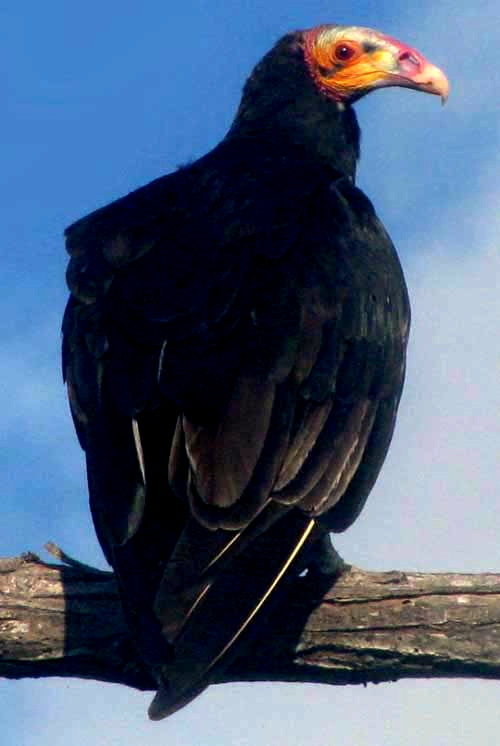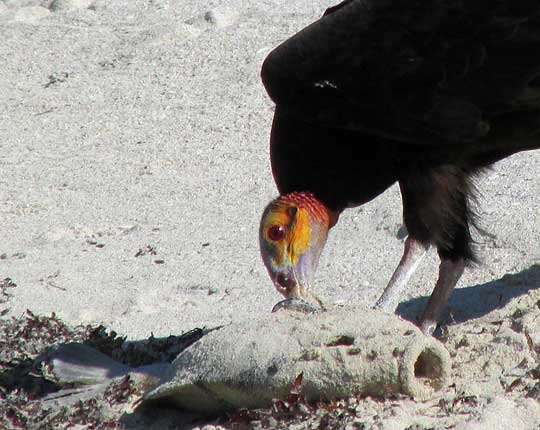Excerpts from Jim Conrad's
Naturalist Newsletter
from the October 9, 2011 Newsletter issued from Mayan Beach Garden Inn 20 kms north of Mahahual; Caribbean coastal beach and mangroves, ~N18.89°, ~W87.64°, Quintana Roo state, MÉXICO
LESSER YELLOW-HEADED VULTURE
Most days this week, right before dawn, it began raining, then on and off during the rest of the day showers moved in off the Caribbean keeping things wet. However, for a couple of hours Wednesday morning the sun came out and not only I but also the birds emerged to enjoy drying out. Among birds perching in early-morning sunlight beside the white sand road was the one shown below:

Vulture, yes, but not like the ones usually seen here. In the Yucatán we have four vulture species. The most commonly seen is the Black Vulture, the stubby-winged one with white patches on his wing undersides. Also common are Turkey Vultures, with longer wings, all-black plumage, and fingerlike feathers spreading at the tips of narrower wings. Very rarely one sees mostly-white King Vultures. And then there's the fourth species, the one in our picture.
Vultures have featherless, or "naked," heads so gunk doesn't get stuck behind feathers as the heads withdraw from carrion. Skin on the head of adult Black vultures is black, while head skin of adult Turkey Vultures is red. We don't have a mostly-white King Vulture, so that leaves us noticing that the skin on our vulture's head is partly red like a Turkey Vulture's, but also there's a good bit of yellowish orange and some whiteness.
This is an immature Lesser Yellow-headed Vulture, sometimes called Savanna Vulture, CATHARTES BURROVIANUS. It's resident from southeastern Mexico south through Central America to northern Argentina in South America. The species' habitat preferences are listed as marshes, savannas, open grasslands and mangroves. They're shown as existing throughout the entire Yucatán Peninsula, but I've only seen them along the coasts, and nowhere commonly, though this week I've seen several here.
Mature Lesser Yellow-headed Vultures lack the white shown in our immature's face. They have the orange, but then also there's a broad bluish-purple band at the bill's base, a pale blue crown, and a blood-red nape band. Adults show little of the pinkishness seen on our immature. I'm going into detail here because in A Guide to The Birds of Mexico and Northern Central America Howell reports the juvenile plumage as undescribed, guessing that the head "probably has dusky eyes and bill, greyish head... "
Lesser Yellow-heads are very similar to Turkey Vultures, being in the same genus. You can see that the base head-skin color of our immature is like that of the Turkey Vulture perching a few trees away at www.backyardnature.net/n/11/111009yw.jpg
from the March 15, 2015 Newsletter issued from Río Lagartos, on the Yucatan Peninsula's northern coast (~N21.60°, ~W88.16°), Yucatán state, MÉXICO
LESSER YELLOW-HEAD EATING A FISH
This week a good view came up of one feeding on a washed-up fish on a Gulf of Mexico Beach, shown below:

I read that Lesser Yellow-heads are dependent on other animals to open the hides of larger animal carcasses, since their bills aren't strong enough to do so. This one seems to have found the fish's soft underbelly, however, so maybe it had done its own work.